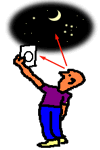The On Line Almanac / Star Finder FAQ
1- What is the precision of the celestial calculations?
- Sun +/- 0.4'
- Stars +/- 0.2'
- Planets +/- 0.4'
- Moon +/- 0.3' (recently improved)
2- What is Hi?
Hi or Instrumental altitude here is the celestial body calculated
altitude corrected for parallax, atmospheric refraction and Semidiameter
of the body (For Sun and Moon. Lower limb ). It does not account for Height
of the Eye (Dip) and Index error (IE), which depend on the sextant and
the navigator's vertical position. In other words, it is the expected
apparent altitude at a certain time and location.
To get the Corrected Altitude - the expected sextant reading in the estimated position - you must subtract these quantities (Dip and IE).
3- How to correct for Dip and IE ?
Dip can be calculated by the formula Dip=-0.97*sqrt(h/0.3048)
(in minutes)
where h is Height of the Eye (in meters) relative to the sea-level.

Index Error is error in the "zero" of the sextant. Point the sextant horizontally and adjust so that the horizon forms a continuous line. Then read the Index Error in the drum.
4- Semidiameter? What is it?
The sun and moon have appreciable diameters (about 0.5°). It
is difficult to read the sextant altitude of the center of these bodies.
It's easier to read the altitude for the lower limb (the lower point of
the ball).
The Instrumental Altitude is corrected for Semidiameter (sun and moon) for the lower limb of the body, as shown below.

5- What is time validity of this almanac?
It depends on the heavenly body. For sun and stars, it is very
long (say thousands of years). For planets and the moon, the precision
decreases after a 100 years. As a general rule, calculations are safe
between 1950 and 2050.
6- Why are the stars listed in this order in the Navigator screen?
Stars in the list box are ordered by descending apparent brightness.
These 59 stars have Magnitude less than 3.0 (the lower the Magnitude,
the brighter the star). Sirius is the brightest.
7- What is a Civil Twilight?
Civil Twilights are the moments when the sun center is 6° below
the horizon (dusk and dawn). These are convenient times to measure altitudes
because it's dark enough to see them (stars and planets) and the horizon
is clearly visible.
The celestial navigator must be ready to take sextant readings at these times. Times for Civil Twilights are calculated when you choose the Sun.
8- More details about calculation methods?
Check this page
9- Can I put the Navigator star finder in my web site?
Yes. I have made it simple to setup a link that displays the sky in a given position and current time. Suppose your city is located at latitude 23°30'S and longitude 46°30' W.
- Convert these numbers to real format, using the dot as decimal separator.
In the example, we get
Lat = -23.5 (use negative values for South) and Lon = 46.5 (negative values for East). - The link must be in the format http://www.tecepe.com.br/cgi-win/cgiasvis.exe/lat:lon .Current GMT time will be used.
- The link in our example is:
<a href="http://www.tecepe.com.br/cgi-win/cgiasvis.exe/-23.5:46.5">The sky over São Paulo, now</a>
Please post me a message with the Internet address of your page.
10- Printing the Star Finder
If you want to print a hard copy of the star finder, select the Printer Friendly check box on the initial form. This gives a larger, white background chart.
 |
11- Why East and West are flipped ? You may notice that E and W sides are swapped. This is called overhead view, and is supposed to be read upside down, as you look up to the sky (see left).
|
12 - What are the grid lines and circles in the star finder chart ?
The star finder is a polar chart. The vertical and horizontal lines represent the NS and EW directions (true). The circles are the 0°, 30° and 60° constant altitude lines. The outer circle (H=0°) is the horizon. The chart center is the Zenith, the point in the vertical, above your head.
|
13- How can I estimate angles in the sky ? As a rough estimate, with your arm extended, your fist measures about 10°. |
Suggested reading
| >> "Night Watch "
by Terence Dickinson ISBN 1-55209-302-6 - 176 pages |
|
||
| Excellent guide to the night sky for amateur astronomers. Amazing images. Don't buy a telescope before reading it. | |||
©Copr 92-2012 Omar F. Reis - All rights reserved